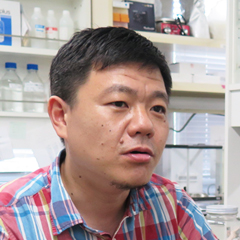A crucial step in the life cycle of root parasitic plants is germination. Because they are unable to survive without attaching to a host plant, they can germinate only in the presence of the host. In the 1960s, researchers identified a chemical, named strigol, which is secreted from the host plant root and acts as a germination stimulant for the root parasitic plant, Striga hermonthica. Structurally similar chemicals have been isolated from other plant species and are now collectively called strigolactones. Root parasitic plants detect the presence of the host nearby by sensing strigolactone molecules exuded from the host root. With the discovery of strigolactones as the germination stimulant for root parasitic plants, the question arises “Why does the host plant produce and exude such a chemical into the soil?” In 2005, a Japanese group discovered that strigolactones act as a signal that induces symbiosis with a type of beneficial microbe called arbuscular mycorrhizal fungi. Moreover, in 2008, another Japanese group found that strigolactones act as plant hormones that regulate shoot branching in the plant. Therefore, root parasitic plants have adapted to make use of plant exudates, which have different important roles in the host, to stimulate their germination.
In Japan, the problem of root parasitic plants causing significant damage to crop production has not been reported. However, an alien species called O. minor was first discovered in the 1930s and has now spread to many places in Japan. Therefore, it poses a potential threat to agriculture. In 2015, three groups independently identified a strigolactone receptor protein KAI2d in S. hermonthica. Moreover, a genetic search revealed the presence of at least five KAI2d genes in O. minor. However, the functional importance of O. minor KAI2d (OmKAI2d) has not yet been evaluated. Therefore, our group analyzed the function of each OmKAI2 (OmKAI2d1 to OmKAI2d5) and found that OmKAI2d3 and OmKAI2d4 had the ability to act as strigolactone receptors. In particular, when expressed in Arabidopsis, OmKAI2d3 was found to have a picomolar sensitivity to strigolactone. Moreover, our structural and biochemical analysis of OmKAI2d4 suggested that this receptor might recognize various strigolactone molecules, potentially supporting the ability of O. minor to interact with a variety of host plants.
Our findings provide an important step that helps pave the way for the development of effective tools to control the germination of root parasitic plants.
* The information contained herein is current as of September 2023.
* The contents of articles on Meiji.net are based on the personal ideas and opinions of the author and do not indicate the official opinion of Meiji University.
* I work to achieve SDGs related to the educational and research themes that I am currently engaged in.
Information noted in the articles and videos, such as positions and affiliations, are current at the time of production.


